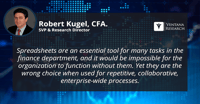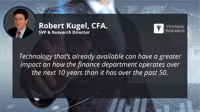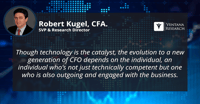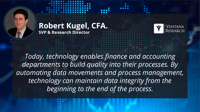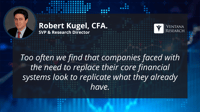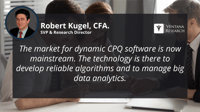One of the challenges of being a practically minded technology analyst is squaring the importance of “the next big thing” with the reality of what most organizations are doing. For decades it’s been the case that “the next big thing” in the world of information technology is easily several years ahead of where most organizations are in their use of technology. And before most organizations can realize the benefit of some whiz-bang technology, they frequently need to address a range of more...
Read More
Topics:
Human Capital Management,
Marketing,
Office of Finance,
Analytics,
Business Intelligence,
Sales Performance Management,
Financial Performance Management,
Price and Revenue Management,
Digital Marketing,
Work and Resource Management,
Digital Commerce,
Operations & Supply Chain,
Enterprise Resource Planning,
ERP and Continuous Accounting,
robotic finance,
Predictive Planning,
revenue and lease accounting,
Subscription Management,
intelligent sales,
AI & Machine Learning
We find in our recent Change in the Office of Finance benchmark research an indication of the value of using automation to execute finance department functions. Our findings reveal an increase in the use of automation by finance organizations over the past five years and a concomitant improvement in performance. For example, 46 percent of companies close their monthly books within four business days compared to 29 percent in our earlier research. Yet the glass is only half full. Finance...
Read More
Topics:
Office of Finance,
Financial Performance Management,
Price and Revenue Management,
ERP and Continuous Accounting,
robotic finance,
Predictive Planning,
revenue and lease accounting
One of the objectives of our recent Change in the Office of Finance benchmark research was to assess the technological capabilities of finance and accounting departments. The research confirms that today we are on the verge of a major technology-led shift. Technology that’s already available can have a greater impact on how the finance department operates over the next 10 years than it has over the past 50. Advances in columnar databases, in-memory processing and artificial intelligence and ...
Read More
Topics:
Office of Finance,
Financial Performance Management,
Price and Revenue Management,
ERP and Continuous Accounting,
robotic finance,
Predictive Planning,
revenue and lease accounting,
Subscription Management
I was invited to sit on a panel at CFO 3.0 events held in San Francisco and New York hosted by Sage Intacct. This event is about the evolution of the role that started with the archetypal CFO 1.0, the green-eye-shade-wearing bean counter. Lacking usable technology, he or she was limited to keeping the books in good order and simply reporting what just happened. Today’s CFO 2.0 relies on technology developed over the past two decades as well as the broader perception of the role, catalyzed by...
Read More
Topics:
Office of Finance,
Financial Performance Management,
Price and Revenue Management,
ERP and Continuous Accounting,
robotic finance,
Predictive Planning,
revenue and lease accounting
Ventana Research recently announced its 2020 research agenda for the Office of Finance, continuing the guidance we’ve offered for nearly two decades on the practical use of technology for the finance and accounting department to help these organizations derive greater value and improve their performance. For decades organizations have discussed transforming Finance from a backward-looking “bean counter” to a more strategic advisory role — yet little has changed. One important reason is that the...
Read More
Topics:
Office of Finance,
Price and Revenue Management,
ERP and Continuous Accounting,
robotic finance,
Predictive Planning,
revenue and lease accounting
Yes, it’s an easy metaphor, but a worthwhile one to consider. For the Office of Finance, figures are its raw material. They are transformed and assembled into financial statements, forecasts and reports. Like a factory, there are blueprints (accounting standards, models and forms) that show how the parts are to be pieced together. There’s quality control in the form of internal audit. And there are final inspections — external audits — to ensure the end product has been assembled properly.
Read More
Topics:
Office of Finance,
Financial Performance Management,
Price and Revenue Management,
ERP and Continuous Accounting,
robotic finance,
Predictive Planning,
revenue and lease accounting
Sage Intacct recently hosted its annual user group meeting, Advantage, and earlier this year met with industry analysts. Both meetings shed light on how the company is addressing two key opportunities. One is building a robust offering to address rapidly evolving technology requirements for the Office of Finance. The other is broadening the scope of its offering to address the financial management and administration needs of its customers.
Read More
Topics:
Office of Finance,
business intelligence,
Financial Performance Management,
ERP and Continuous Accounting,
robotic finance,
Predictive Planning,
revenue and lease accounting,
AI & Machine Learning
Configure, price and quote (CPQ) software has been around for decades. Lately, I’ve been using the term “Dynamic CPQ” to apply to a variant of this software category that explicitly aims to produce a quote that optimizes the trade-off between the profitability of a deal and the probability of closing a sale. Dynamic CPQ software is a hybrid of price and revenue optimization (PRO) software and CPQ, providing companies with the ability to better execute their market share and pricing strategies....
Read More
Topics:
Customer Experience,
Office of Finance,
Data Preparation,
Information Management,
Sales Performance Management,
Financial Performance Management,
Price and Revenue Management,
robotic finance,
revenue and lease accounting,
sales enablement
The traditional office of finance has five main organs: accounting keeps the books; financial planning and analysis (FP&A) analyzes performance and manages the forward-looking activities of the company such as planning, budgeting and forecasting; corporate finance raises outside money; treasury takes care of the cash and bank accounts, and tax. The modern office of finance requires a sixth: Finance IT (FIT).
Read More
Topics:
Office of Finance,
Analytics,
Financial Performance Management,
Price and Revenue Management,
Digital Technology,
Operations & Supply Chain,
ERP and Continuous Accounting,
blockchain,
robotic finance,
Predictive Planning,
Conversational Computing,
revenue and lease accounting,
collaborative computing,
Subscription Management,
AI & Machine Learning
By itself, data isn’t useful for business; the application of analytics is necessary to transform data into actionable information. Data analysis of one sort or another has long been a core competence of finance departments, applied to balance sheets, income statements or cash flow statements. Today, however, Finance must go beyond these basics by expanding the scope of the data being examined to include all financial and operational information that can yield actionable insights. Analysis thus...
Read More
Topics:
Customer Experience,
Human Capital Management,
Marketing,
Voice of the Customer,
business intelligence,
embedded analytics,
Learning Management,
Analytics,
Collaboration,
Data Governance,
Data Lake,
Data Preparation,
Information Management,
Internet of Things,
Contact Center,
Data,
Product Information Management,
Sales Performance Management,
Workforce Management,
Financial Performance Management,
Price and Revenue Management,
Digital Technology,
Digital Marketing,
Digital Commerce,
ERP and Continuous Accounting,
blockchain,
natural language processing,
robotic finance,
Predictive Planning,
candidate engagement,
Intelligent CX,
Conversational Computing,
Continuous Payroll,
revenue and lease accounting,
collaborative computing,
mobile computing,
Subscription Management,
agent management,
extended reality,
AI & Machine Learning



